Master Bamboo Care for Austin's Unique Climate
Stop killing your bamboo plants—master the proven care methods that guarantee healthy, thriving bamboo in any Austin home. Our comprehensive guide, tailored for Central Texas environments, empowers you to cultivate lush, resilient greenery.
- Climate-specific watering schedules tested across 200+ Austin homes
- Troubleshooting guides developed from real customer problems
- Seasonal care adjustments proven to work in Central Texas conditions
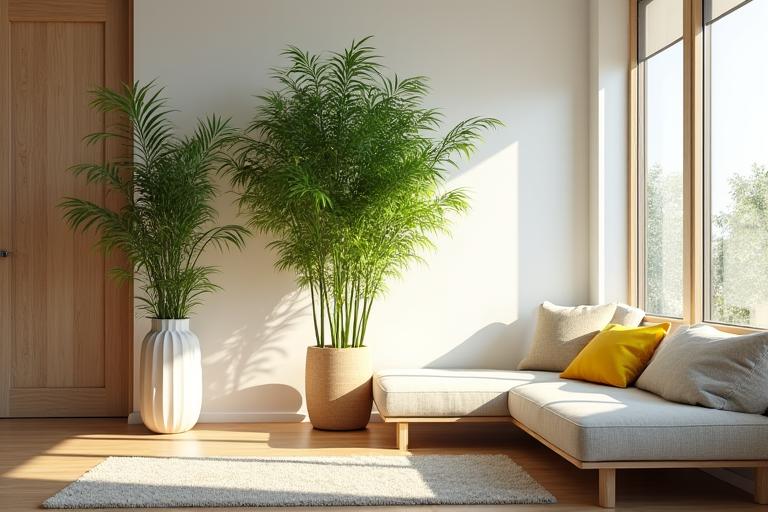
See the Difference:
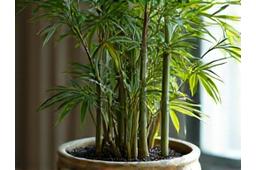
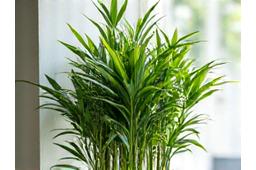
Bamboo Care Fundamentals for Success
Cultivating vibrant indoor bamboo starts with understanding these essential elements. Our guide simplifies complex horticultural needs into actionable steps for every Austin home.
Optimal Lighting
Discover the ideal placement for various indoor bamboo varieties, balancing natural light with protection from harsh Austin sun. Learn to identify signs of too much or too little light.
Learn MoreLucky bamboo thrives in bright, indirect light. Avoid direct, intense afternoon sun which can scorch leaves. Monitor leaf color: fading green often indicates too much light, while dark green with stunted growth suggests too little.
Precise Watering
Master the art of watering for Austin's fluctuating humidity. Understand soil moisture levels, filtration needs, and how to avoid the common pitfalls of over or under-watering.
Learn MoreUse filtered or distilled water if possible, as tap water chemicals can harm bamboo. Keep roots consistently moist, but not waterlogged. Allow the top inch of soil to just dry out between waterings. Adjust frequency seasonally.
Temperature Stability
Create an optimal thermal environment for your indoor bamboo. Learn how Austin's seasonal temperature swings affect plant health and strategies to maintain consistent indoor conditions.
Learn MoreBamboo prefers temperatures between 65-90°F (18-32°C). Avoid placing plants near drafty windows, air conditioning vents, or heat sources that cause sudden temperature fluctuations, which can stress the plant.
Humidity Management
Counter Austin's sometimes dry indoor air. Discover effective techniques for boosting humidity around your bamboo to prevent dry leaf tips and maintain vibrant foliage.
Learn MoreMist your bamboo daily or place it near a humidifier. A pebble tray filled with water beneath the pot (ensure the pot isn't sitting directly in water) can also effectively increase local humidity.
Essential Supplies
Equip yourself with the right tools and supplies for successful bamboo cultivation. From potting mix to pruning shears, know what's necessary for thriving plants.
Learn MoreKey supplies include a well-draining potting mix, clean water source, sharp pruning shears, and potentially a good quality, balanced liquid fertilizer for house plants. Consider a moisture meter for precise watering.
Austin's Monthly Bamboo Care Calendar
Navigate the year with confidence using our specific care calendar, tailored for Central Texas. Adjust your routine for Austin's unique climate patterns, from humid summers to unexpected winter chills.
January
Minimal watering, focus on indoor temperature stability. Check for pests in drier indoor air. Prepare for spring growth.
February
Slight increase in watering if indoor air is dry. Begin light fertilization for emerging growth. Monitor for any signs of dormancy issues.
March
Active growth begins. Increase watering frequency and start a consistent fertilization schedule. Consider repotting if roots are crowded.
April
Peak spring growth. Ensure consistent moisture. Protect from direct afternoon sun as intensity increases. Boost humidity if needed.
May
Monitor for summer heat. Adjust watering to remain moist but not soggy. Check for mites as temperatures rise. Ensure good air circulation.
June
Hot Austin summer. Daily humidity checks. Water thoroughly and frequently. Avoid placing near open windows during midday heat.
July
Intense heat. Potentially water twice daily for smaller pots. Ensure maximum shade from direct sun. Continue strong humidity efforts.
August
Sustained heat. Maintain summer care routine. Watch for signs of heat stress (leaf curl, browning tips). Consider temporary relocation to cooler spot.
September
Temperatures begin to moderate. Gradually reduce watering frequency. Prepare for less intense light. Check for late-season pests.
October
Active growth slows. Reduce fertilization. Ensure plants are away from drafts as cooler air approaches. Prepare for indoor heating.
November
Winter preparation. Water sparingly. Maintain consistent indoor temps. Rotate plants for even light exposure. Focus on plant stability.
December
Dormancy period. Minimal watering and no fertilization. Protect from cold air and drafts. Ensure ambient humidity remains adequate.
Common Bamboo Problems & Solutions
Even the most resilient bamboo can encounter issues. Our expert troubleshooting guide provides clear, actionable solutions for common ailments, ensuring your plant's swift recovery and continued vitality.
Yellowing Leaves (Tip and Stalk)
Diagnosis: Often caused by overwatering, mineral buildup from tap water, or insufficient light. In Austin's climate, mineral buildup is particularly common due to hard water.

Solution: Ensure proper drainage and allow soil to dry slightly between waterings. Switch to filtered or distilled water. Increase indirect light exposure. Trim yellow leaves carefully with clean shears.
Root Rot & Mushy Stems
Diagnosis: A serious issue due to consistently waterlogged soil, common in pots without adequate drainage or with too frequent watering. Stems will feel soft and appear discolored.
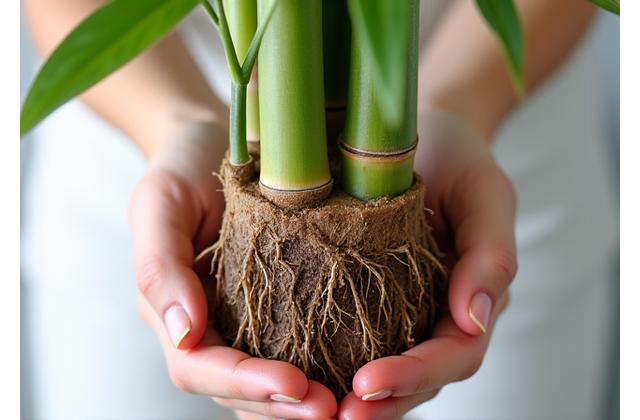
Solution: Act quickly. Remove the plant from the pot, gently rinse roots, and trim away any black or mushy sections. Repot in fresh, well-draining soil. Reduce watering frequency significantly. Ensure adequate air circulation.
Stunted Growth or Leggy Stalks
Diagnosis: Lack of proper light, nutrient deficiency, or overcrowding in the pot. Bamboo needs consistent conditions to thrive.
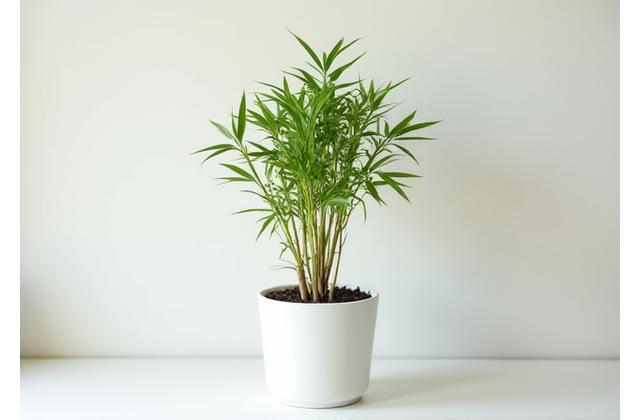
Solution: Move to a brighter location with indirect light. Consider a balanced liquid fertilizer during growing seasons. If overcrowded, propagate or repot into a larger container to give roots more space.
Pest Infestations (Spider Mites, Mealybugs)
Diagnosis: Small webs, sticky residue, or tiny white cottony masses on leaves and stalks. Austin's dry spells can sometimes encourage spider mites indoors.
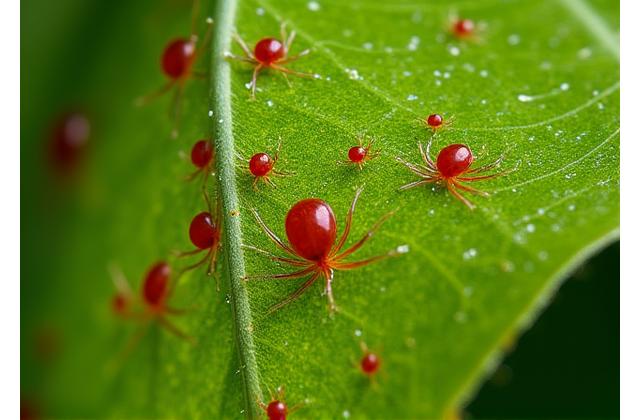
Solution: Isolate the plant. Use a damp cloth to wipe away pests. Treat with neem oil spray or insecticidal soap diluted in water. Repeat weekly until clear. Increase humidity to deter spider mites.
Expert Tips for Thriving Bamboo
Ready to elevate your bamboo care? These advanced techniques will help you propagate new plants, maintain mature specimens, and unlock their full botanical potential.

Propagating New Growth
Expand your bamboo collection effortlessly. Learn the simple, effective methods for propagating new stalks from existing healthy plants, ensuring a continuous supply of vibrant greenery for your home or to share with friends.
- Choose a healthy, mature stalk with at least two nodes.
- Cut a section about 6-8 inches long using clean, sharp shears.
- Place the cutting in a vase with filtered water, ensuring at least one node is submerged.
- Change the water weekly and place in bright, indirect light until roots emerge.
- Once rooted, plant in a small pot with well-draining soil.
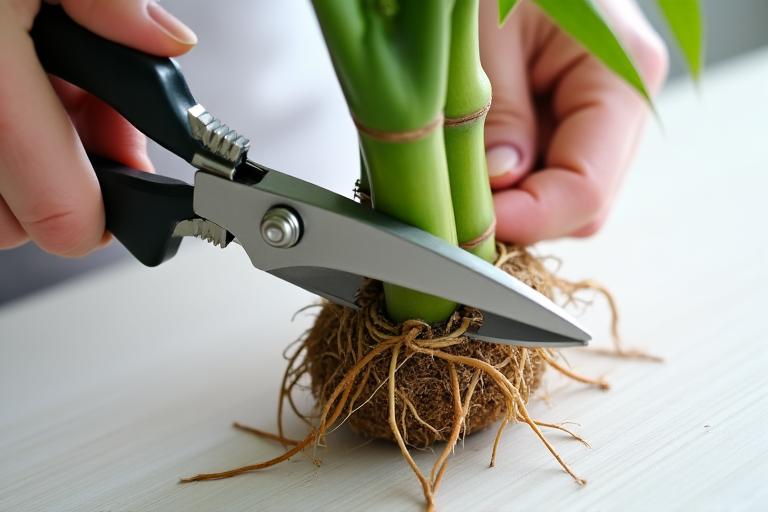
Root Pruning for Container Health
For long-term container bamboo success, occasional root pruning is key. This technique prevents your plant from becoming root-bound, promotes healthier growth, and allows for continued lush foliage without needing excessively large pots.
- Gently remove the plant from its pot.
- Loosen the outer roots; trim up to one-third of the root ball.
- Repot with fresh potting mix, ensuring good drainage.
- This encourages new root growth, leading to a healthier plant.
Essential Bamboo Care Tools & Supplies
Equip yourself with the right resources to ensure your bamboo thrives. We've curated a list of must-have tools and recommended supplies, with insights into finding them right here in Austin.

Premium Potting Mix
A well-draining, nutrient-rich mix is crucial. Look for blends with perlite or coarse sand to prevent waterlogging, adapted for Austin's humid climate.
Local Austin Supplier: Green Thumbs Nursery
Find Local Suppliers
Sharp Pruning Shears
Clean, sharp shears are essential for precise cuts, preventing disease and promoting healthy growth. Ideal for trimming yellow leaves or shaping stalks.
Local Austin Supplier: The Gardener's Co-Op
View Recommended Products
Filtered Water System
Austin's tap water can contain minerals harmful to bamboo. A simple filter or leaving water out overnight can make a significant difference.
Local Austin Supplier: Pure Water Solutions
Learn More About WaterTrack Your Bamboo's Health Progress
Become a true bamboo master by consistently monitoring your plants. Our simple framework helps you track growth, identify changes early, and celebrate your success in cultivating resilient greenery.
Your Monthly Health Assessment Checklist
- Check leaf color and texture for vibrant green and firmness.
- Inspect stalks for firmness and absence of discoloration.
- Evaluate soil moisture retention and drainage effectiveness.
- Look for new growth points and overall plant vigor.
- Scan for any signs of pests (webs, sticky residue, tiny dots).
- Document changes with photos to compare progress over time.
Pro Tip: Use your smartphone to snap monthly progress photos. It's the best way to visualize improvement or catch issues early.
Need Help Deciphering? Consult an Expert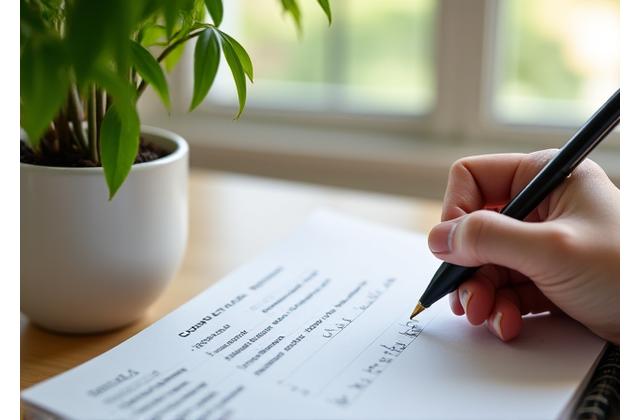
Get Personalized Bamboo Care Advice
Sometimes, a plant problem is unique, or you just prefer expert guidance. Cyndroxalenium Everbloom Organics offers personalized consultation services for your specific bamboo care challenges in Austin.
Why Choose Our Consultation?
- Free Initial Assessment: Briefly discuss your plant's issue at no charge.
- Tailored Care Plans: Receive a custom plan based on your home's unique environment and your specific bamboo variety.
- Troubleshooting Masterclass: Get hands-on guidance for complex issues like severe root rot or persistent pest problems.
- Ongoing Support: Options for follow-up support to ensure long-term success.
Ready to Transform Your Home?
Don't let struggling plants diminish your serene living space. Our experts are ready to help. Book a session conveniently online.
Book Your ConsultationQuestions? Call us at +1 (512) 302-0762 or email info@cyndroxalenium.com